Given their nearly identical, interesting and even amusing feeding technique Mountain chickadees almost seem like wannabe nuthatches.
Yesterday I posted an image of a Red-breasted Nuthatch hanging upside down from a Douglas Fir cone after extracting one of its seeds. That nuthatch photo and the following five Mountain Chickadee photos were all taken two days ago as the birds were foraging for food in the same area in the mountains and mostly in the same tree.
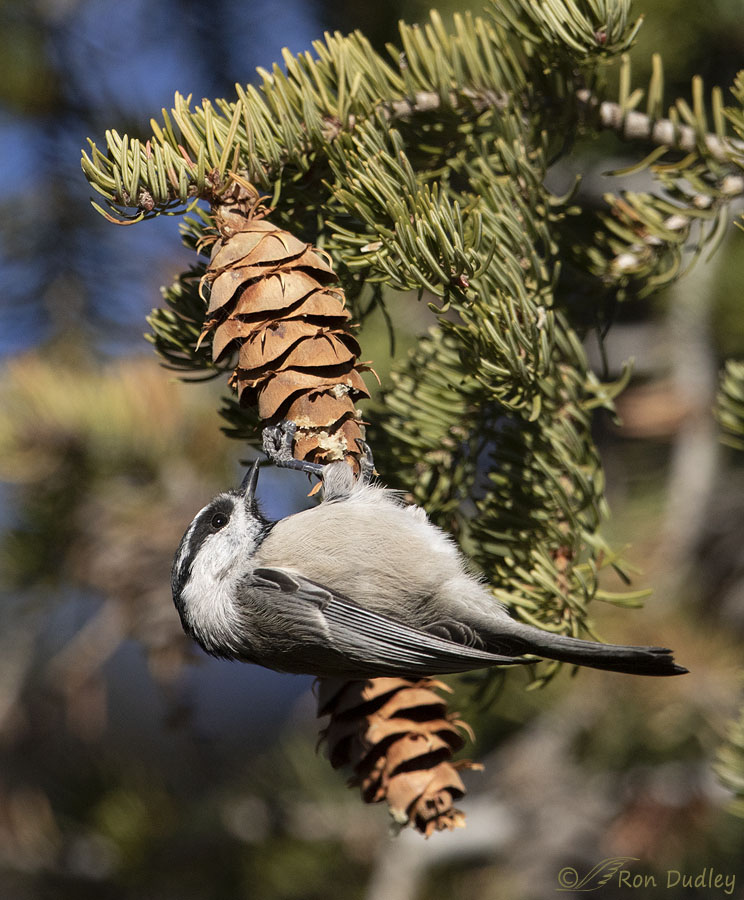
1/4000, f/6.3, ISO 800, Canon 7D Mark II, Canon EF 500mm f/4L IS II USM + EF 1.4 III Extender, not baited, set up or called in
Like nuthatches their typical feeding technique this time of year is to extract seeds from the cones. When the seeds are found between scales higher up on a cone they cling vertically to the side of the cone but for lower seeds they have to hang upside down from the bottom of the cone in a process known as “hang-gleaning”.
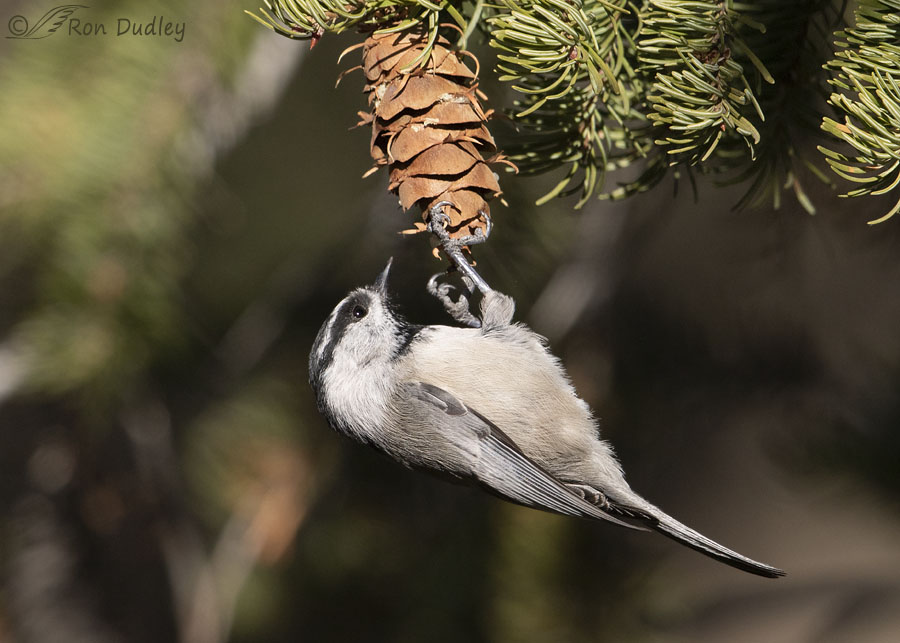
1/2500, f/6.3, ISO 800, Canon 7D Mark II, Canon EF 500mm f/4L IS II USM + EF 1.4 III Extender, not baited, set up or called in
Extracting seeds from between the cone scales isn’t easy but they seem to be very proficient at it. Hanging from a single foot appears to be no problem for them so their feet must be well adapted for holding on.
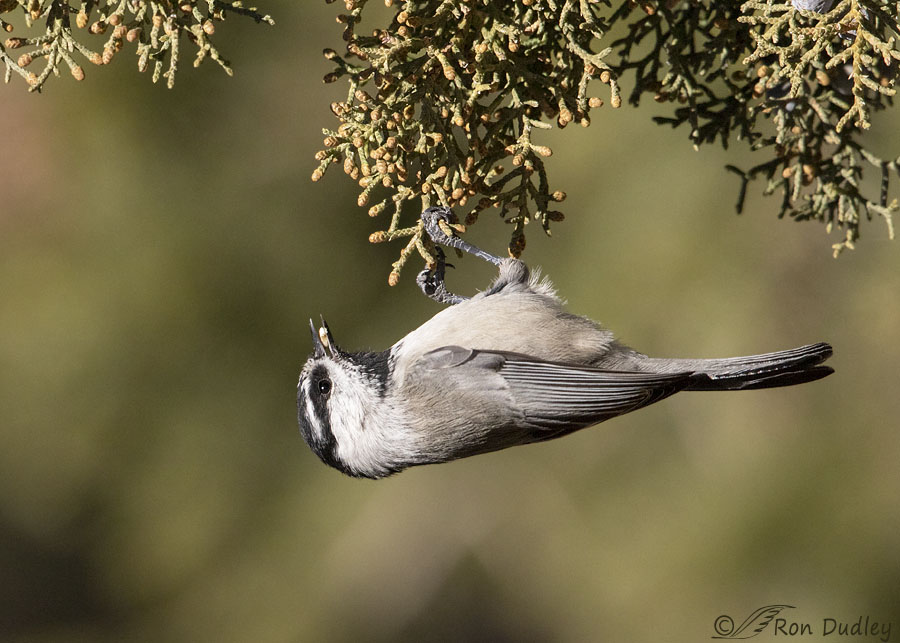
1/5000, f/6.3, ISO 800, Canon 7D Mark II, Canon EF 500mm f/4L IS II USM + EF 1.4 III Extender, not baited, set up or called in
They use a similar technique while feeding in junipers.
This species eats insects and spiders during warm months and mostly conifer seeds when it’s cold. I find no mention in the literature of them eating plant parts other than seeds or occasionally fruits so I’m slightly puzzled about this bird appearing to eat juniper leaves/needles. Who knows, maybe that’s something else in its bill.
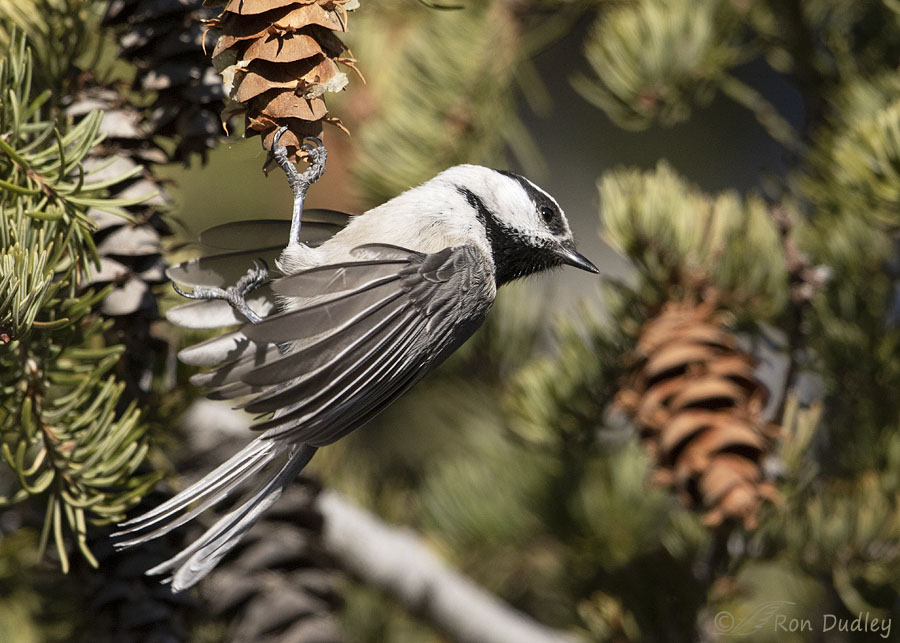
1/4000, f/6.3, ISO 800, Canon 7D Mark II, Canon EF 500mm f/4L IS II USM + EF 1.4 III Extender, not baited, set up or called in
Leaving the cone safely can be a little tricky with all the nearby obstructions.
One of the few differences I believe I’ve noticed in the feeding technique of nuthatches and chickadees is that chickadees don’t seem to hang upside down vertically from the cone and then just drop straight down head first when they leave like nuthatches often do (as seen in the nuthatch pose in yesterday’s post). Instead they usually twist their bodies into a right-side-up orientation as they’re leaving the cone. This bird has released one foot from the cone and is about to rotate 180° as it flies away.
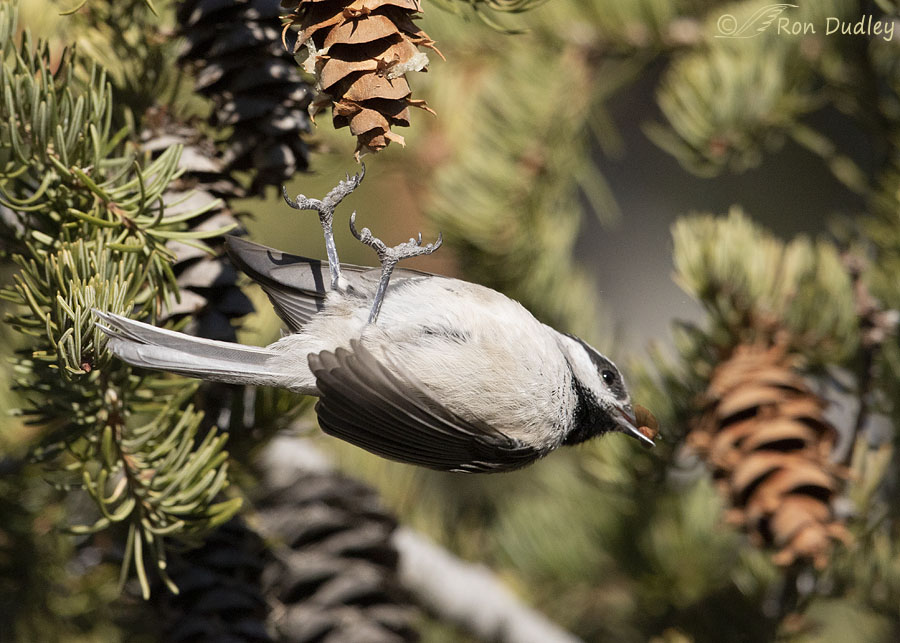
1/6400, f/6.3, ISO 800, Canon 7D Mark II, Canon EF 500mm f/4L IS II USM + EF 1.4 III Extender, not baited, set up or called in
This bird chose to let go of the cone with both feet at the same time resulting in a free fall just before it rotated to right-side-up in the air.
Notice the seed in its bill with the bract still attached. From what I observed I believe these birds, including the nuthatches, were caching most of the seeds they gathered rather than eating them on the spot.
After all, it’s going to be a long winter.
Ron
Note: For those who may be unfamiliar with this species the most obvious field mark distinguishing Mountain Chickadees from the very closely related and more common Black-capped Chickadees is their white supercilium stripe over the eye which interrupts the black cap.
Addendum: In the end I couldn’t resist. I had to see what the 3rd photo would look like if I turned it upside down so the chickadee is right side up. Would it look “normal”? Or not. And if not, why?
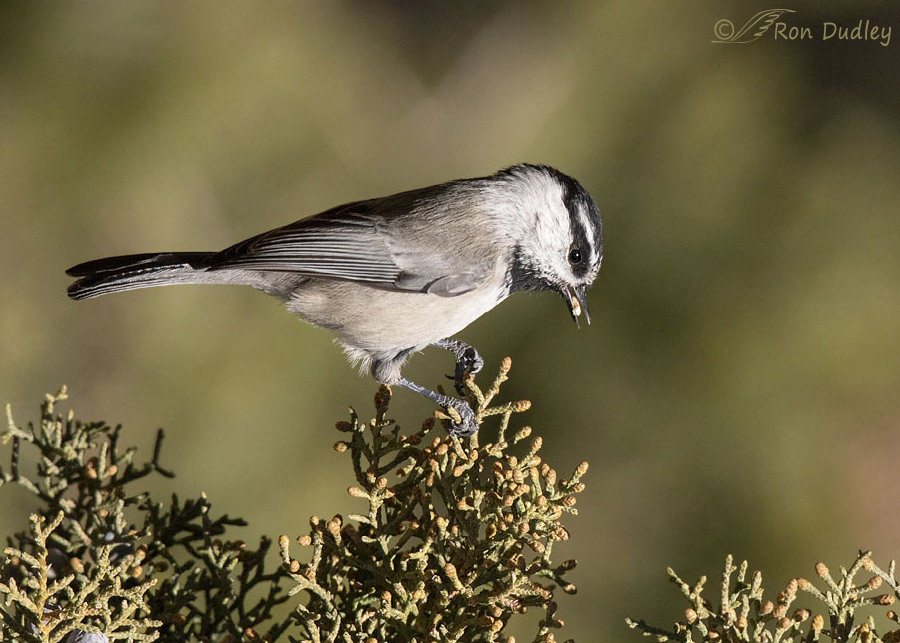
To me it doesn’t look as normal as I thought it might. I think it’s because of the shadow on the top of the bird. To get that shadow up there the sun would have to be far below the horizon which just doesn’t happen when there’s direct sunlight on the bird.
I dunno, maybe flat-earthers believe it could happen. Somehow…


These guys have the most amazing Velcro toes, you get one on your hand and they are impossible to shake off!
They are amazing, imitating much of the agility of the nuthatches. Great shots!
Apologies if anyone else said this before me — didn’t read the other comments first today. Although the little mandibular morsel in shot 3 looks like a seed upon my first glance, I wonder if it might be a little juniper bud obtained by grabbing onto a “leaf” while changing or steadying position (there looks to be a missing bud just in front of the right foot in that shot). Either way, that is one acrobatic species. I’m nervous (but deliciously so) going upside-down in a roller coaster when I’m totally strapped in!
As for your first sentence, I wonder which came first, the nuthatch or the chickadee (and yes, I was going to abbreviate names, but it just didn’t sound right).
Yes, as I mentioned I think that’s probably what it is, Marty. If I remember correctly it played around with it in its bill for a while but I’m not sure it was swallowed – maybe yes, maybe no.
Yesterday Nuthatches and today Chickadees. I could look at your photos of these guys all winter long. Keep ‘em coming.
Ha, I wish all I had to do was just post them, Lyle. First I’ve gotta take them and that ain’t easy!
The upside down image of the upside down chickadee doesn’t look rightside up to me. That’s because the juniper bracts are abnormally vertical, to my eye. Of course, if you hadn’t provided text with the images, and showed the last image first, I may very easily have glided right over the anomaly. I’m not as alert as I used to be. My telomeres must need changing.
Good point about the juniper, Martha. I hadn’t thought of that.
Love those little Chickadees. The Black Capped ones in my yard come to a feeder right side up. lol When they are in the bushes or trees they are upside down. Love the cute things, but hard to get a picture of them as always on the move! Thanks for the beautiful shots.
Thank you, Trudy.
I can definitely see the differences between the nuthatch and chickadee in these photos and thx for the clear identifier between the mountain and black cap! I would have had trouble “noticing” the issues you mentioned with the upside down photo! Only thing I noticed was the feet position which seemed a bit odd to me….. I love the “free fall” photo and the 1 foot hold on the cone…
I love the “free fall” photo and the 1 foot hold on the cone…  Well done!
Well done! 
To me that white supercilium really stands out, probably because I’ve seen so many Black-capped and far fewer Mountain Chickadees. Thanks, Judy.
Flat earthers…snort! I am most amused by that “launch” shot where the bird is twisting in midair. Looks like an Olympic diver to me.
Arwen, I couldn’t resist that flat-earther dig. Yesterday on CNN I read a very disturbing article about that growing movement so in this context flat earthers jumped to the forefront in my mind.
https://www.cnn.com/2019/11/16/us/flat-earth-conference-conspiracy-theories-scli-intl/index.html
The retired science teacher in me wants to SCREAM!!!!!
I know the feeling…
Beautiful photos and very interesting Ron. They sure are very acrobatic birds. Responding to a previous Mountain Chickadee post I said that I have never seen them here, and I have not. I checked with one of our local bird authorities and he laughingly invited me over to his backyard where he has dozens of them visiting daily. I have not yet done so, but will soon.
Sounds like you need to put a feeder out, Everett!
The freefall…just tooo goood!
I’m glad you enjoyed it, Dave. I get a kick out of it too.
As always, thanks for the ornithology lesson this time on Chickadees. Interesting what you did with the last image. I didn’t see the issue until your explained. That image could have been one of those when you challenge the viewer with “what’s wrong with this image.” For me, it’s hard to see upfront and I’m sure it would have taken me awhile, perhaps long enough that I would have sent you a message saying “I don’t get it!”. Nice images and miss Chickadee antics here in S. Arizona.
“That image could have been one of those when you challenge the viewer with “what’s wrong with this image.”
Our minds work alike, Frank. I thought about doing exactly that but only after I’d posted it.